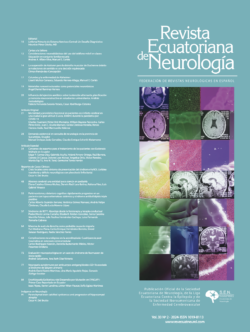Artículo original
Factores de riesgo cardiovascular y etiología del ictus en adultos jóvenes. Cardiovascular risk factors and stroke etiology in young adults.
Autor: Claudio Scherle-Matamoros, Dannys Rivero-Rodríguez, Daniella Di Capua-Sacoto, Alejandro Lescay-RojasRev. Ecuat. Neurol. VOL 33 Nº1, 2024
Objetivos: Describir la etiología del ictus y la frecuencia de los factores de riesgo cardiovascular en un grupo de pacientes con menos de 50 años, ingresados en la unidad de ictus de un hospital terciario público del Ecuador.
Pacientes y métodos: Estudio descriptivo y retrospectivo de corte transversal, de pacientes con 50 años y menos de edad ingresados entre noviembre del 2016 y agosto 2019. Se analizaron datos demográficos, factores de riesgo cardiovascular, tipo de ictus, la etiología, tiempo síntoma puerta y el tiempo de estadía en el departamento de neurología. Los resultados se compararon entre sexos.
Resultados: se incluyeron en el estudio 45 pacientes. La edad media fue de 38 ± 10 años y sin diferencias entre sexos. El 77,8% contaba con algún factor de riesgo cardiovascular. Predominó consumo de alcohol (33,3%), seguido del tabaquismo y la dislipidemia (22,2%). En general y por sexo el ictus isquémico (75,5%) fue el más frecuente. La hemorragia intracerebral representó el 24,4%. En la etiología del ictus isquémico predominó la causa inhabitual (35,3%), seguido del ictus cardioembólico (26,8%) y el de etiología indeterminada. Para la hemorragia intracraneal, la etiología más frecuente fue la hipertensión arterial (63,3%).
Conclusiones: La alta frecuencia de al menos un factor de riesgo cardiovascular, sumado al retardo en la llegada al hospital, constituyen una alerta para insistir en la prevención primaria y en la realización de campañas de divulgación sobre el ictus.
Objectives: To describe the etiology of stroke and the frequency of cardiovascular risk factors in a group of patients under 50 years of age, hospitalized in the stroke unit of a public tertiary hospital in Ecuador.
Patients and methods: Descriptive and retrospective cross-sectional study of patients aged 50 and under, admitted between November 2016 and August 2019. Demographic data, cardiovascular risk factors, type of stroke, etiology door symptom time and the length of stay in the neurology department were analyzed. The results were compared between sexes.
Results: 45 patients were included. The mean age was 38 ± 10 years and there were no differences between the sexes. The 77.8% had some cardiovascular risk factors. Alcohol consumption predominated (33.3%), followed by smoking and dyslipidemia (22.2%). In general, and by sex, ischemic stroke (75.5%) was the most frequent. Intracerebral hemorrhage represented 24.4%. In the etiology of the ischemic stroke, an unusual cause predominated (35.3%), followed by cardioembolic stroke (26.8%) and that of undetermined etiology. For intracerebral hemorrhage, the most frequent etiology was hypertension (63.3%).
Conclusions: The high frequency of at least one modifiable cardiovascular risk factor, added to the delay in arrival at the hospital, constitute an alert to consider the need to insist on primary prevention and carry out information campaigns aimed to improve knowledge of the disease.





